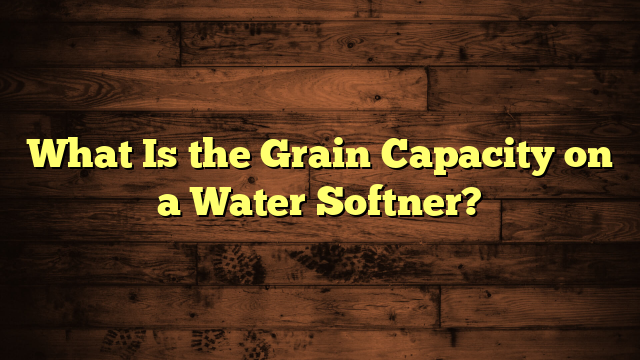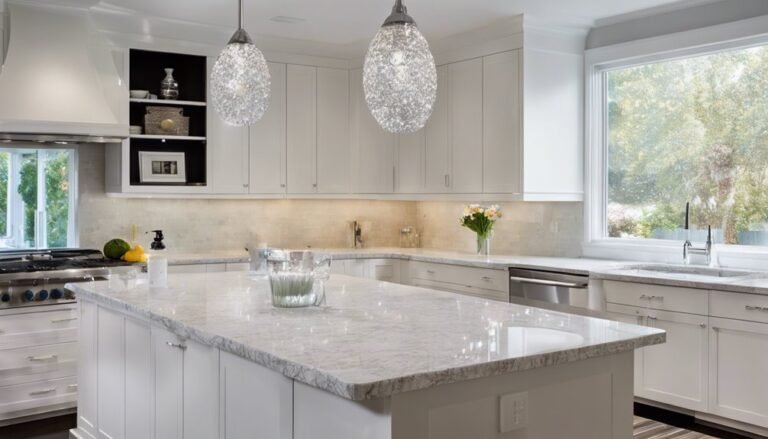What Part of House That Has Water Softner?
You might think water softeners belong in a secret lair, hidden away from sight, but in reality, their placement is far more practical. You need to evaluate where to install one in your home for ideal functionality. Typically, you'll find these units near the main water line, often in the laundry room or basement, but that's not the only option. Choosing the right location can greatly impact your water quality and system efficiency. So, which areas of your home truly benefit the most from a water softener's presence?
Key Takeaways
- The water softener is typically installed near the main water line for optimal performance.
- Common locations include the laundry room or basement, providing necessary plumbing access.
- Placing the unit in the kitchen ensures softened water is available for cooking and drinking.
- Adequate drainage for brine discharge during regeneration is crucial for installation.
- Avoid extreme temperatures and ensure ventilation to maintain the water softener's integrity.
Understanding Water Softeners
A water softener is an essential component in managing hard water issues in your home. Water hardness primarily stems from high levels of calcium and magnesium ions. These minerals can cause scale buildup, reduce appliance efficiency, and lead to dry skin. Understanding the softening process is vital in mitigating these effects.
The softening process typically involves ion exchange, where hard water passes through a resin bed filled with sodium ions. As the hard water flows through, calcium and magnesium ions attach to the resin, and sodium ions are released into the water. This exchange effectively reduces water hardness, ensuring that you get softer water for household use.
You'll need to monitor the salt levels in the brine tank regularly, as this is essential for regenerating the resin beads after they become saturated with hardness minerals.
The frequency of regeneration depends on your water softener's capacity and your household's water usage. By understanding these technical aspects, you're better equipped to maintain your water softener, ensuring you consistently enjoy the benefits of soft water throughout your home.
Ideal Locations for Installation
Choosing the right location for your water softener installation is crucial for ideal performance. You'll want to prioritize areas where water enters your home, typically near the main water line. Common choices include the laundry room or basement, as these spaces usually provide the necessary plumbing access.
For kitchen placement, consider positioning the unit close to the water supply line feeding your kitchen. This guarantees that softened water is readily available for cooking and drinking, enhancing the quality of your household water. However, keep in mind that the kitchen can be a high-traffic area, so make sure the installation doesn't obstruct movement.
When evaluating the laundry room, it's often the most practical location. This area typically has adequate space for the softener, and having softened water readily available for washing clothes can greatly improve their longevity and cleanliness.
Moreover, confirm there's proper drainage for the brine discharge during regeneration cycles. In both cases, maintain adequate ventilation and avoid locations exposed to extreme temperatures to preserve the unit's integrity.
Ultimately, selecting an ideal installation location guarantees optimized water softening and contributes to the overall efficiency of your plumbing system.
Common Areas in Homes
When considering the installation of a water softener, it is vital to identify common areas in your home that can effectively support its function. Typically, these areas include the kitchen and bathrooms, where water usage is at its highest. Proper placement guarantees that both kitchen faucets and bathroom fixtures benefit from softened water, enhancing their performance and longevity.
| Area | Importance |
|---|---|
| Kitchen | Reduces scale buildup in appliances |
| Bathroom | Protects fixtures from corrosion |
| Laundry Room | Improves detergent efficiency |
| Whole House | Consistent water quality |
| Outdoor | Maintains landscaping health |
Benefits of Proper Placement
Proper placement of a water softener in your home can greatly enhance the efficiency of your plumbing system and improve overall water quality. By strategically positioning your water softener near the main water line, you guarantee that all water entering your home is treated effectively. This placement benefits not only your appliances but also your plumbing fixtures, reducing the buildup of scale and extending their lifespan.
Moreover, a well-placed water softener can optimize salt usage, minimizing waste and lowering your operational costs. When you choose a location that allows easy access for maintenance and replenishment, you further enhance its efficiency and performance.
Consider placing the unit in a temperature-controlled environment to avoid issues related to freezing or overheating, which can affect functionality. Additionally, proper placement minimizes the risk of leaks and flooding, safeguarding your property from potential water damage.
Maintenance Considerations
After enhancing the placement of your water softener, regular maintenance becomes a key factor in ensuring its long-term performance.
To maintain peak water quality, establish a maintenance schedule that includes regular checks of salt levels, resin cleanliness, and system efficiency.
You should inspect the brine tank every month, ensuring it has adequate salt. If you notice significant salt bridges or crusting, it's time to break them up or replace the salt entirely.
Furthermore, every six months, clean the resin beads with a resin cleaner to remove any buildup that can hinder performance.
Monitor your water softener's output regularly. If you notice a decline in water quality—like increased hardness in your water—this could indicate a need for more frequent regeneration cycles or a review of your system's settings.
Moreover, consider scheduling professional maintenance annually. A technician can conduct a thorough inspection, recalibrate settings, and replace any worn components.
Impact on Plumbing Systems
The installation of a water softener can greatly impact your home's plumbing system, particularly in terms of efficiency and longevity. Softened water can markedly reduce pipe corrosion caused by hard minerals, extending the life of your plumbing. Furthermore, by reducing scale buildup in pipes and appliances, you'll maintain ideal water pressure throughout your home.
Here's a quick overview of how a water softener affects your plumbing system:
| Impact Area | Effect |
|---|---|
| Pipe Corrosion | Reduces corrosion rates |
| Scale Buildup | Minimizes buildup |
| Water Pressure | Maintains ideal levels |
| Appliance Longevity | Extends lifespan |
| Maintenance Frequency | Decreases needs |
Connection to Main Water Supply
Understanding how a water softener connects to your main water supply is fundamental for maximizing its benefits. The main connection typically occurs where your water supply enters your home, guaranteeing that all water flows through the softener before reaching your fixtures.
It's imperative to install the system correctly to prevent any bypass of untreated water, which can undermine the softening process. Start by locating the main water line, usually found in the basement or near the water meter.
You'll need to cut into this line to create a connection point for your softener. This involves shutting off the water supply, draining the system, and using appropriate fittings to connect the softener to the main line.
It's essential to verify that you're using the right size and type of pipe to maintain ideal flow rates. Don't forget to install a bypass valve. This allows you to divert water around the softener when maintenance is required.
Finally, check for leaks at all connection points post-installation. A secure, leak-free connection guarantees that your water supply remains efficient and that your water softener operates effectively, providing you with high-quality softened water throughout your home.
Signs You Need a Water Softener
Hard water can lead to a range of issues in your home, and recognizing the signs that you need a water softener is essential for maintaining your plumbing and appliances.
One of the most common hard water signs is the presence of scale buildup on faucets, showerheads, and appliances. This mineral accumulation reduces efficiency and can lead to costly repairs.
You might also notice soap scum forming in your sinks and bathtubs, which indicates that your soap isn't lathering effectively due to high mineral content. Your laundry may feel stiff or look dingy, signaling that hard water is affecting your fabrics.
Furthermore, if you experience frequent clogs in your plumbing, it could be a result of mineral deposits.
Investing in a water softener can provide numerous softened water benefits. It not only extends the lifespan of your appliances but also enhances the effectiveness of soaps and detergents, leading to cleaner dishes and laundry.
In addition, softened water can improve your skin and hair, making them feel softer and healthier. By addressing these hard water signs promptly, you can protect your home and enjoy the advantages of softened water.
Frequently Asked Questions
Can I Install a Water Softener Myself?
Yes, you can handle a DIY installation of a water softener. By following manufacturer guidelines, you'll enjoy softener benefits like reduced scale buildup and improved water quality, enhancing your home's overall plumbing efficiency.
How Much Does a Water Softener Cost?
Water softener prices range from $400 to $2,500, depending on capacity and features. Installation costs typically add $200 to $500. Consider these factors to guarantee you choose the best option for your needs.
Do Water Softeners Consume a Lot of Electricity?
Think of a water softener as a diligent gardener. It doesn't consume much electricity; its energy efficiency guarantees minimal power consumption while nurturing your home's water, alleviating hard mineral burdens without burdening your utility bill greatly.
Are There Different Types of Water Softeners?
Yes, there are different types of water softeners. You'll find salt-based systems using ion exchange to remove hard minerals, while salt-free alternatives use various methods to inhibit mineral buildup and maintain water quality without traditional salt.
How Long Do Water Softeners Typically Last?
You might think a water softener lasts forever, but its lifespan's typically around 10-15 years. Regular maintenance tips, like cleaning brine tanks and checking salt levels, can extend its functionality and efficiency considerably.
Conclusion
Choosing the right location for your water softener isn't just about convenience; it's about efficiency and effectiveness. By installing it near the main water line, you guarantee peak performance, protect your plumbing system, and enjoy the benefits of softened water throughout your home. Prioritize accessibility, proper drainage, and temperature control to enhance longevity. When you invest in thoughtful placement, you invest in better water quality, a healthier home, and peace of mind. Don't underestimate the power of location.







